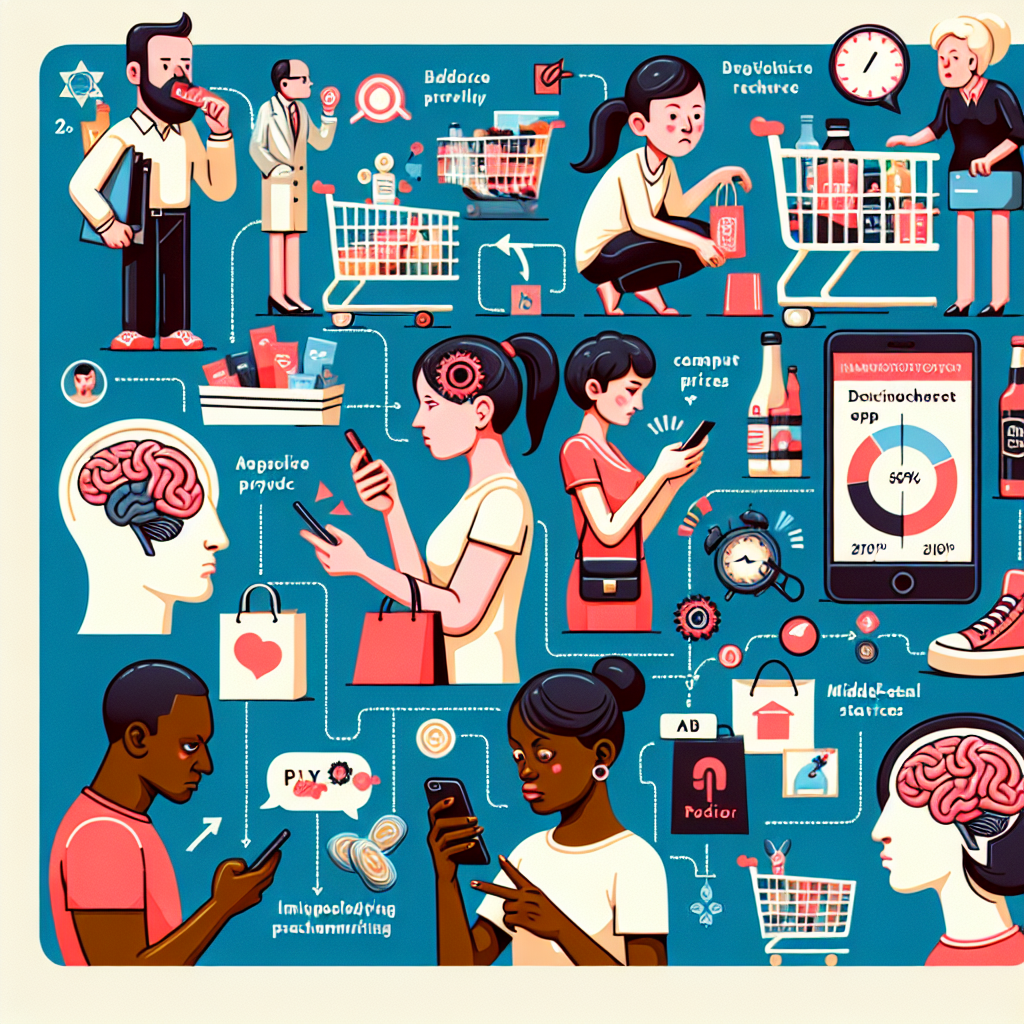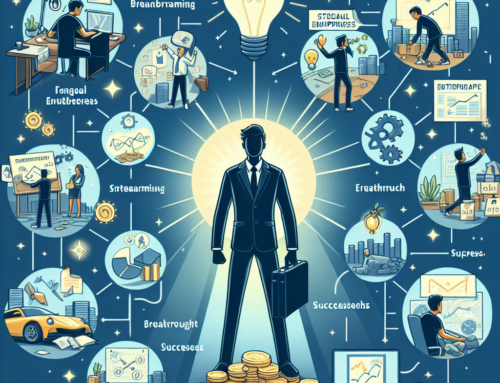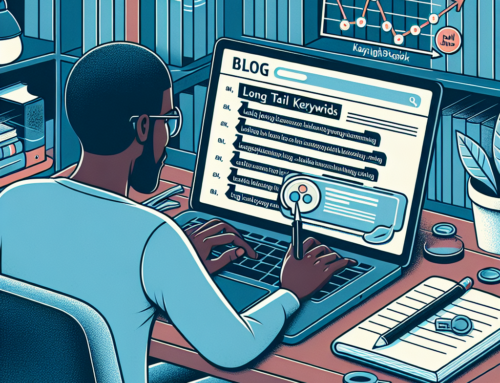
The Power of Persuasion: Understanding the Psychology Behind Consumer Behavior
Have you ever wondered why you are drawn to certain products or why you make certain purchasing decisions? The answer lies in the psychology behind consumer behavior. As consumers, we are constantly bombarded with advertisements and marketing strategies that aim to persuade us to buy certain products. But what exactly makes us susceptible to these tactics? In this article, we will delve into the psychology behind consumer behavior and how businesses can use it to their advantage.
One of the key factors that influence consumer behavior is the concept of social proof. This refers to the tendency of individuals to conform to the actions and opinions of others. In simpler terms, we are more likely to buy a product if we see others using or recommending it. This is why businesses often use testimonials and reviews from satisfied customers in their marketing campaigns. By showcasing positive experiences from others, they are able to create a sense of trust and credibility in their product.
Another important aspect of consumer behavior is the power of emotions. Studies have shown that emotions play a significant role in decision-making, even when it comes to purchasing products. Advertisements that evoke strong emotions such as happiness, fear, or nostalgia are more likely to be remembered and have a lasting impact on consumers. This is why companies often use emotional appeals in their advertisements, as it can create a strong connection between the consumer and the product.
In addition to emotions, the concept of scarcity also plays a role in consumer behavior. When a product is perceived to be limited in quantity or availability, it creates a sense of urgency and exclusivity. This can lead consumers to make impulsive purchases, as they fear missing out on the opportunity to own the product. Businesses often use this tactic by offering limited edition products or running flash sales to create a sense of scarcity and increase demand.
The psychology behind consumer behavior also includes the concept of cognitive biases. These are mental shortcuts that our brains use to make decisions quickly and efficiently. However, these biases can also lead us to make irrational decisions. One common bias is the anchoring effect, where our initial perception of a product’s value influences our willingness to pay for it. This is why businesses often use the strategy of setting a higher initial price for a product, as it can anchor the perceived value in the minds of consumers.
Furthermore, the power of persuasion also lies in the use of persuasive language. Certain words and phrases can have a significant impact on consumer behavior. For example, using words like ”limited time offer” or ”exclusive deal” can create a sense of urgency and scarcity, while words like ”free” or ”discount” can trigger the desire for a bargain. Businesses carefully choose their words in advertisements and marketing materials to appeal to the emotions and desires of consumers.
So how can businesses use the psychology behind consumer behavior to their advantage? Firstly, understanding the factors that influence consumer behavior can help businesses tailor their marketing strategies to target specific demographics. For example, if a product appeals more to younger consumers, businesses can use social media platforms to reach this audience. Secondly, by understanding the power of emotions and cognitive biases, businesses can create more effective and persuasive advertisements. And finally, by utilizing persuasive language and creating a sense of scarcity, businesses can increase demand for their products.
In conclusion, the psychology behind consumer behavior is a powerful tool that businesses can use to their advantage. By understanding the factors that influence consumer behavior and utilizing persuasive tactics, businesses can effectively reach and persuade their target audience. As consumers, it is important to be aware of these tactics and make informed decisions when making purchases. So the next time you find yourself drawn to a product, remember that it may be the result of clever marketing and the psychology behind consumer behavior.
The Role of Emotions in Consumer Decision Making: How to Tap into the Emotional Side of Your Customers
When it comes to consumer behavior, there is more to it than just rational decision making. In fact, emotions play a significant role in how consumers make purchasing decisions. As a business owner, understanding the psychology behind consumer behavior and how to tap into the emotional side of your customers can greatly benefit your business.
Firstly, it is important to understand that emotions are a powerful driving force in consumer behavior. Studies have shown that emotions can influence up to 90% of our daily decisions, including what products we buy and where we buy them from. This is because emotions are closely tied to our memories and experiences, making them a key factor in how we perceive and interact with brands.
One of the most common emotions that influence consumer behavior is fear. Fear can be triggered by a variety of factors, such as the fear of missing out (FOMO) or the fear of making the wrong decision. This is why limited time offers and scarcity tactics are often used by businesses to create a sense of urgency and encourage consumers to make a purchase.
On the other hand, positive emotions such as happiness and excitement can also play a significant role in consumer behavior. When consumers feel happy and excited about a product or brand, they are more likely to make a purchase and become loyal customers. This is why creating a positive and enjoyable shopping experience for your customers is crucial in building a strong emotional connection with them.
Another important aspect of consumer behavior is the role of social influence. Humans are social creatures, and we often look to others for guidance and validation. This is why social proof, such as customer reviews and testimonials, can greatly impact consumer behavior. When consumers see others using and enjoying a product, they are more likely to trust and purchase it themselves.
In addition to social influence, the concept of self-image also plays a significant role in consumer behavior. People often use products and brands to express their identity and values. This is why businesses that align their brand with certain values and beliefs can attract a loyal customer base. For example, a company that promotes sustainability and eco-friendliness may appeal to consumers who value environmental responsibility.
Now that we understand the role of emotions in consumer behavior, how can businesses tap into the emotional side of their customers? The key is to create an emotional connection with your target audience. This can be achieved through various strategies, such as storytelling, personalization, and creating a sense of community.
Storytelling is a powerful tool that can evoke emotions and create a connection between a brand and its customers. By sharing your brand’s story and values, you can appeal to the emotions of your target audience and build a sense of trust and authenticity.
Personalization is another effective way to tap into the emotional side of your customers. By tailoring your products or services to meet the specific needs and preferences of your customers, you can make them feel valued and understood. This can create a strong emotional bond and increase customer loyalty.
Lastly, creating a sense of community can also be a powerful way to tap into the emotional side of your customers. By fostering a community around your brand, you can create a sense of belonging and connection for your customers. This can lead to increased brand loyalty and word-of-mouth marketing.
In conclusion, emotions play a crucial role in consumer behavior, and businesses that understand and tap into the emotional side of their customers can greatly benefit. By creating a positive and emotional connection with your target audience, you can increase customer loyalty, attract new customers, and ultimately drive business success. So, don’t underestimate the power of emotions in consumer behavior and use it to your advantage.
The Influence of Social Proof on Consumer Behavior: Leveraging Social Media and Reviews to Drive Sales
When it comes to consumer behavior, there are many factors at play. From personal preferences to marketing tactics, understanding what drives consumers to make purchasing decisions is crucial for businesses. One of the key factors that influence consumer behavior is social proof. In this article, we will delve into the psychology behind social proof and how businesses can leverage it through social media and reviews to drive sales.
So, what exactly is social proof? Simply put, it is the idea that people are more likely to follow the actions of others in a given situation. This can be seen in various aspects of our lives, from fashion trends to restaurant choices. In the context of consumer behavior, social proof refers to the influence that other people’s opinions and actions have on our own decision-making process.
One of the main reasons why social proof is so powerful is because of our innate desire to fit in and belong. As social beings, we tend to look to others for guidance on what is considered acceptable or desirable. This is especially true in situations where we are unsure or unfamiliar with a product or service. In these cases, we are more likely to rely on the experiences and opinions of others to inform our own decisions.
With the rise of social media, the impact of social proof on consumer behavior has only increased. Platforms like Instagram, Facebook, and Twitter have become powerful tools for businesses to showcase their products and services. By leveraging social media influencers, businesses can tap into their large following and use their influence to promote their brand. When consumers see their favorite influencers using and endorsing a product, they are more likely to view it as desirable and trustworthy.
Another way businesses can use social media to leverage social proof is through user-generated content. This refers to content created by consumers themselves, such as reviews, testimonials, and user-generated photos. According to a survey by BrightLocal, 91% of consumers between the ages of 18-34 trust online reviews as much as personal recommendations. This highlights the importance of reviews in influencing consumer behavior.
Reviews not only provide social proof but also serve as a form of word-of-mouth marketing. When consumers see positive reviews from others, they are more likely to trust the product or service and make a purchase. On the other hand, negative reviews can have a significant impact on consumer behavior, as they can deter potential customers from buying a product or service.
In addition to social media, businesses can also leverage social proof through their own website. By displaying customer testimonials and reviews on their website, businesses can build trust and credibility with potential customers. This is especially important for e-commerce businesses, where customers cannot physically see or touch the product before making a purchase.
Aside from social media and reviews, businesses can also use other forms of social proof to influence consumer behavior. This includes celebrity endorsements, expert opinions, and social validation through numbers and statistics. For example, a business can showcase the number of satisfied customers or the percentage of positive reviews to demonstrate the popularity and quality of their product or service.
In conclusion, social proof plays a significant role in consumer behavior and can be a powerful tool for businesses to drive sales. By leveraging social media, reviews, and other forms of social proof, businesses can tap into the innate desire of consumers to fit in and belong. By understanding the psychology behind social proof and using it effectively, businesses can gain a competitive edge and build a loyal customer base.
The Science of Pricing: How to Use Pricing Strategies to Influence Consumer Behavior
Have you ever wondered why you are drawn to certain products or why you are willing to pay a higher price for a particular item? The answer lies in the psychology behind consumer behavior. As consumers, we are constantly making decisions about what to buy and how much to spend. These decisions are not always rational and are often influenced by various factors, including pricing strategies used by businesses.
Pricing is a crucial aspect of marketing and can greatly impact consumer behavior. It is not just about setting a price for a product, but also about understanding the psychology behind how consumers perceive and respond to different pricing strategies. In this article, we will delve into the science of pricing and how businesses can use it to influence consumer behavior.
One of the key principles of pricing psychology is the concept of perceived value. This refers to the value that a consumer believes a product or service has, based on its price. In other words, consumers tend to associate a higher price with higher quality and value. This is why luxury brands can charge exorbitant prices for their products, as consumers perceive them to be of superior quality.
Another important factor in pricing psychology is the power of anchoring. This is the tendency for consumers to rely heavily on the first piece of information they receive when making a decision. For example, if a consumer sees a product with a price tag of $100, they are more likely to perceive a similar product with a price tag of $80 as a good deal, even though it may not be significantly cheaper.
Businesses can use this principle to their advantage by strategically setting their prices. For instance, they can introduce a higher-priced product first, which will act as an anchor for consumers. Then, they can introduce a lower-priced product, which will seem like a better deal in comparison. This is commonly seen in the pricing of electronics, where a higher-priced model is introduced first, followed by a lower-priced model with fewer features.
The concept of loss aversion also plays a significant role in consumer behavior. This refers to the tendency for consumers to place a higher value on avoiding losses than on acquiring gains. In other words, consumers are more likely to be motivated by the fear of missing out on a good deal than the potential to save money.
Businesses can use this principle by offering limited-time discounts or promotions. This creates a sense of urgency and scarcity, making consumers feel like they will miss out on a good deal if they don’t act quickly. This is why we often see phrases like ”limited time offer” or ”while supplies last” in advertisements.
Another pricing strategy that businesses use to influence consumer behavior is the decoy effect. This is when a business offers a third option that is strategically placed to make the other options seem more appealing. For example, a business may offer a small, medium, and large size option for a product. The medium size may be priced slightly higher than the small size, but the large size is priced significantly higher than the medium size. This makes the medium size seem like the best value, even though it may not be the most cost-effective option.
Lastly, businesses can also use pricing psychology to create a sense of exclusivity and prestige. This is often seen in luxury brands that use high prices to create a perception of exclusivity and status. By limiting the availability of a product and pricing it at a premium, businesses can attract consumers who want to be associated with a certain lifestyle or image.
In conclusion, the science of pricing is a powerful tool that businesses can use to influence consumer behavior. By understanding the psychology behind how consumers perceive and respond to different pricing strategies, businesses can strategically set their prices to increase sales and revenue. From perceived value to loss aversion, there are various principles that businesses can use to their advantage. So the next time you make a purchase, remember that there is more to pricing than just a number on a price tag.
Creating a Sense of Scarcity: Using Limited Time Offers and Limited Quantities to Drive Consumer Behavior
Have you ever found yourself rushing to buy something because it was only available for a limited time or in limited quantities? Or have you ever felt a sense of urgency to make a purchase because of a time-sensitive offer? If so, you have experienced the power of scarcity in consumer behavior.
Scarcity is a psychological principle that drives consumer behavior. It is the idea that when something is limited or in short supply, it becomes more desirable and valuable. This concept has been used by marketers and businesses for decades to create a sense of urgency and drive sales. In this article, we will explore the psychology behind scarcity and how businesses can use it to their advantage.
The Fear of Missing Out (FOMO) is a common emotion that drives consumer behavior. When something is scarce, people fear that they will miss out on the opportunity to purchase it. This fear is amplified when there is a time limit involved. Limited time offers, such as flash sales or one-day deals, create a sense of urgency and FOMO in consumers. They feel like they have to act quickly or risk missing out on a great deal.
Limited quantities also play a significant role in consumer behavior. When a product is only available in limited quantities, it creates a sense of exclusivity and rarity. People want to be part of the select few who own the product, and this drives them to make a purchase. Limited quantities also tap into the fear of missing out, as consumers worry that they will not be able to get their hands on the product if they wait too long.
Another psychological factor at play is the idea of loss aversion. People are more motivated to avoid losses than to acquire gains. When something is scarce, consumers feel like they will lose out on the opportunity to purchase it if they do not act quickly. This fear of loss can be a powerful motivator for making a purchase.
So, how can businesses use scarcity to drive consumer behavior? One way is by using limited time offers. These can be in the form of flash sales, one-day deals, or even countdown timers on websites. By creating a sense of urgency, businesses can encourage consumers to make a purchase before the time runs out. This strategy is commonly used in the fashion industry, where limited edition collections are released for a short period, creating a frenzy among consumers to get their hands on the products.
Limited quantities can also be used to drive consumer behavior. Businesses can create a sense of exclusivity by offering products in limited quantities. This can be done through limited edition releases or by limiting the number of products available for purchase. This strategy is often used in the beauty industry, where limited edition makeup collections sell out within minutes of being released.
However, businesses must be careful not to overuse scarcity tactics. If consumers feel like they are constantly being bombarded with limited time offers and limited quantities, they may become desensitized to them. This can lead to a decrease in the effectiveness of these tactics and may even turn consumers away from the brand.
In conclusion, scarcity is a powerful psychological principle that drives consumer behavior. The fear of missing out, loss aversion, and the desire for exclusivity all play a role in creating a sense of urgency and driving sales. Businesses can use limited time offers and limited quantities to tap into these emotions and encourage consumers to make a purchase. However, it is essential to use these tactics strategically and not overuse them. By understanding the psychology behind scarcity, businesses can effectively use it to their advantage and drive consumer behavior.
We have lots of exciting coming events in Entrepreneurship, Investing and Personal Development. You can find them all here:
www.swedishwealthinstitute.se/events




